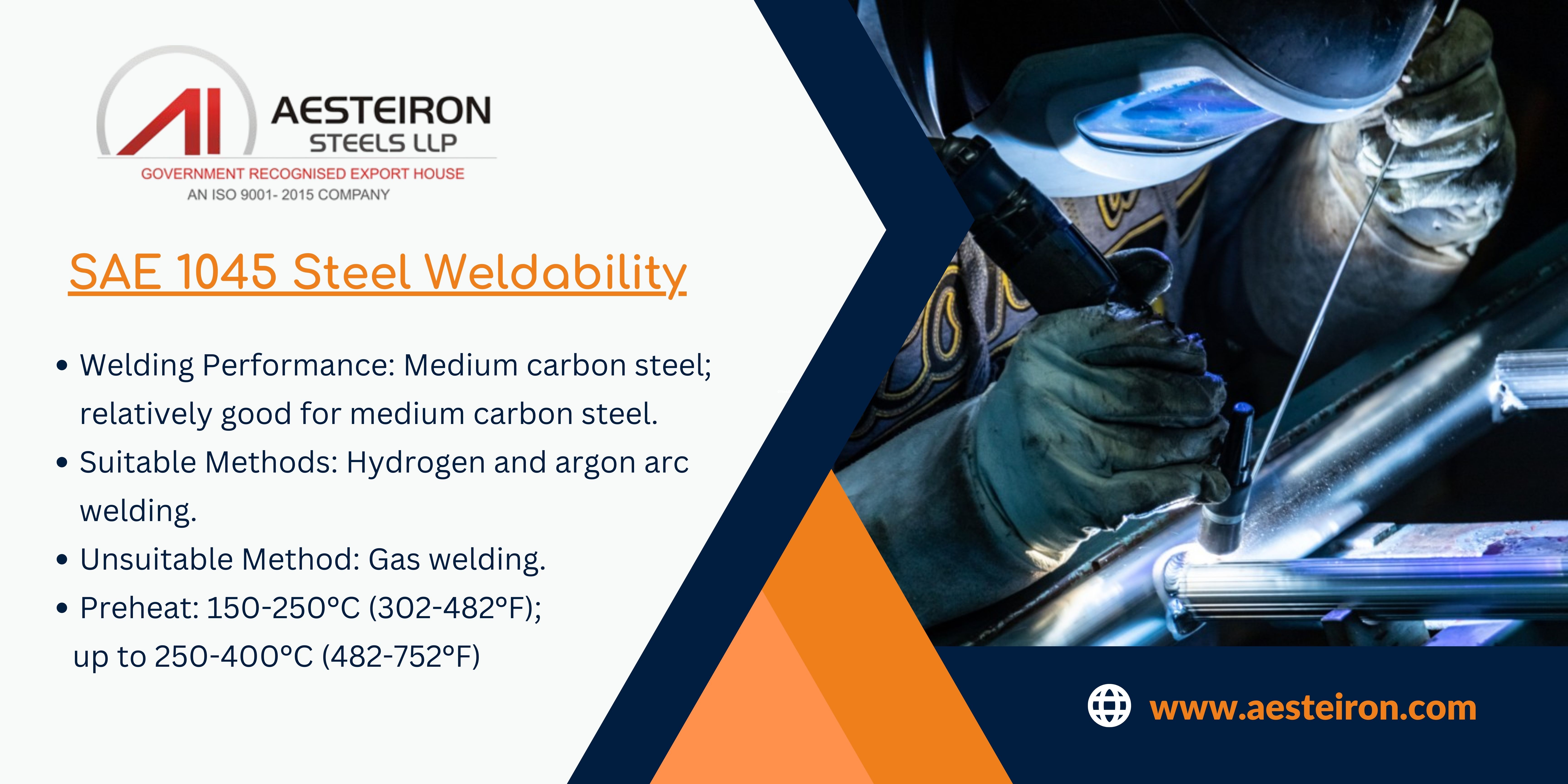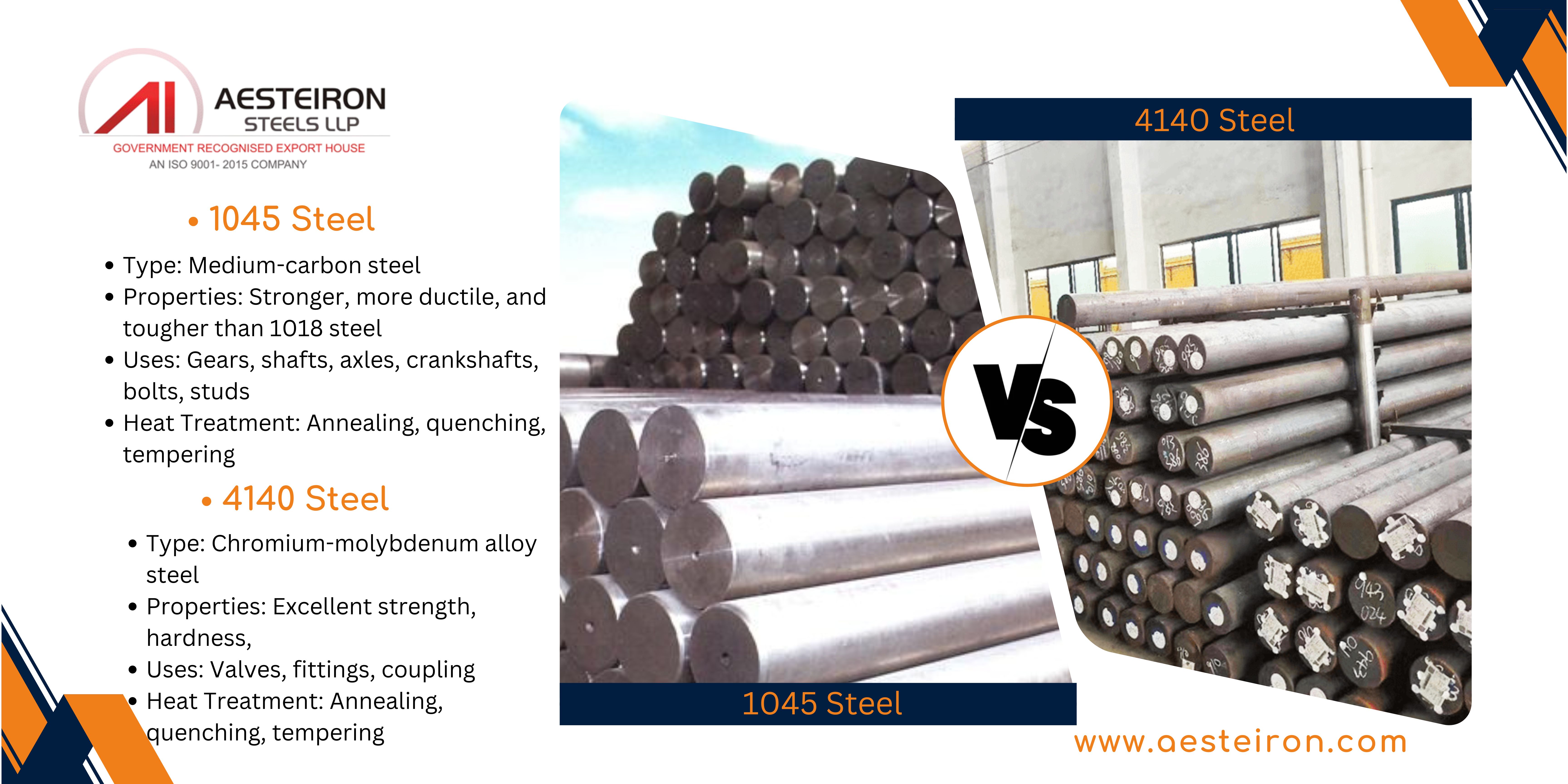Understanding the chemical composition of SAE 1045 steel is crucial as it directly impacts the mechanical properties of the material. The table below provides an overview of its key chemical composition: Table of Contents SAE 1045 Steel Chemical Composition One of the standout features of AISI 1045 steel is its excellent weldability. This allows for the creation of high-quality welds that are strong, durable, and safe, preventing potential damage due to cracks. This characteristic is particularly important in applications where structural integrity is critical. The steel’s good machinability also plays a significant role in its popularity. It can be easily and quickly machined with minimal tools, resulting in superior surface finishes, tighter tolerances, and faster production times. These factors ultimately reduce manufacturing costs. Additionally, the high strength properties of AISI 1045 make it ideal for use in demanding environments such as construction and structural applications where heavy loads and extreme conditions are present. Weldability of ASTM 1045 Steel Mechanical Properties of AISI 1045 Steel (Cold Drawn) Normalized condition offers several advantages, including improved mechanical properties, reduced internal stress, enhanced machinability, and refined grain structure, making it a preferred choice for many applications. Heat Treatment of DIN 1.1191 Comparison: SAE 1045 vs. 4140 Steel Quenched and Tempered Properties of 1045 Steel The following table shows equivalent grades of Steel 1045 according to different national standards. Understanding these equivalents can help ensure compatibility across international projects. Equivalent Grades of AISI 1045 Thermal Properties of SAE 1045 Tolerances of AISI 1045 Carbon Steel During annealing, the material softens, enhancing its machinability and malleability. After reaching the desired temperature range, the material is cooled gradually in a furnace to achieve the required mechanical properties for specific applications. Annealing of Ck45 Steel Quality Assurance for Steel 1045 This steel grade is susceptible to corrosion when exposed to moisture or aggressive environments like acidic or alkaline conditions. To mitigate this issue, additional protective coatings or regular maintenance are often required to enhance its durability and longevity. Corrosion Resistance of AISI 1045 Electrical Properties of JIS S45C Steel Applications of SAE 1045 Steel
Customizable High Quality Aluminium Tube Coiled,Source factory stock,Customizable High Quality Aluminium Tube Coiled,High Quality Aluminium Tube For Heat Exchanger,High quality Aluminium Tube Coiled
Our company has always had strict quality control standards in the market of refrigeration and heat exchange equipment, focusing on providing customised services to our customers. Not only do we have high requirements for the selection of raw materials, but we also keep up to date with the latest production processes and have high testing standards.
Our company mainly produces products for:Fin Evaporator.Fin Type Condenser.Capillary Tube. Coolant Reservoir.Plate Reinforcement Parts.Stamped Parts.Aluminum Tube.Instrument Testing Equipment.
Aluminum Tube,Rectangular Aluminum Tube,Aluminium Tube Coiled,Customizable Rectangular Aluminum Tube Xinxiang Yukun Refrigeration Technology Co.Ltd , https://www.yukunevaporator.com
Grade
C
Si
Mn
P
S
1045
0.43-0.50
0.15-0.35
0.60-0.90
≤0.04
≤0.05
AISI 1045 Steel: Excellent Weldability, Machinability, and High Strength

Aspect
Details
Welding Conditions
AISI 1045 is readily welded if the proper procedures are followed.
Electrodes
Low hydrogen electrodes should be used.
Pre-heating
The workpiece should be pre-heated to 200°C – 300°C (392°F – 572°F).
Welding Temperature
Ensure pre-heat temperature is maintained during welding.
Cooling
Cooling should be controlled by slowly cooling in sand or ashes to manage the cooling rate.
Stress Relief
Stress relief treatments should be performed at 550°C – 660°C (1022°F – 1220°F).
Mechanical Properties
Hardness (Brinell)
Hardness (Rockwell B)
Hardness (Vickers)
Tensile Strength (Yield)
Tensile Strength (Ultimate)
Elongation at Break (in 50 mm)
Reduction of Area
Poisson's Ratio (Typical for Steel)
Modulus of Elasticity (Typical for Steel)
Bulk Modulus (Typical for Steel)
Shear Modulus (Typical for Steel)
Metric
184
84
170
310 MPa
565 MPa
16.00%
40.00%
0.29
200 GPa
140 GPa
80 GPa
Imperial
184
84
170
45000 psi
81900 psi
16.00%
40.00%
0.29
29000 ksi
20300 ksi
11600 ksi
DIN 1.1191 Steel is Commonly Available in Black Hot Rolled or Normalized Forms
Process
Heating Temperature
Cooling Method
Forging
850°C – 1250°C (1562°F – 2282°F)
Cool in a furnace
Annealing
800°C – 850°C (1472°F – 1562°F)
Cool in a furnace
Normalizing
870°C – 920°C (1598°F – 1688°F)
Cool in still air
Stress-Relieving
550°C – 660°C (1022°F – 1220°F)
Cool in still air
Hardening
820°C – 850°C (1508°F – 1562°F)
Quench in water or brine
Tempering
400°C – 650°C (752°F – 1202°F)
Cool in still air

Property
1045 Steel
4140 Steel
Type
Carbon Steel
Alloy Steel
Carbon Content
0.43-0.50%
0.40%
Manganese Content
0.60-0.90%
0.75-1.00%
Chromium
None
Present
Molybdenum
None
Present
Iron (Fe)
98.51-98.98%
96.79-97.78%
Phosphorus (P, max)
0.04%
0.035%
Sulfur (S, max)
0.05%
0.040%
Strength
Good strength and impact resistance
Superior hardness and toughness
Common Uses
Machinery parts, automotive components
Axles, gears, shafts
Characteristics
Moderate hardness and strength
Enhanced wear resistance and toughness
Section Size (mm)
Up to 16mm
17-44 mm
41-100 mm
Tensile Strength (MPa)
700-850
650-800
630-780
Yield Strength (MPa)
500
430
370
Impact Charpy
30
30
30
Elongation in 50mm (%)
14
16
7
Hardness (HB)
210-245
195-235
185-230
Equivalent Grades of Steel 1045
Country
USA
British
Japan
Australia
Standard
ASTM A29
EN 10083-2
JIS G051
AS 1442
Grades
1045
C45/1.1191
S45C
1045
Properties
Metric
Imperial
Thermal Conductivity
51.9 W/mK
360 BTU in/hr.ft².°F
Thermal Expansion Coefficient (@0.000-100°C/32-212°F)
11.2 µm/m°C
6.22 µm/m°C
Surface Finish
Black-Forged
Turned
Black-Rolled
Peeled
Ground
Polished
Cold Drawn
Tolerance
(0, +5mm)
(0, +3mm)
(0, +1mm)
Best H11
Best h9
Best h11
Best H11
Annealing Temperature for JIS S45C Grade Ranges from 790-870°C
Aspect
Details
Purpose of Annealing
To soften the surface for improved machinability
Annealing Temperature
820°C to 840°C
Holding Time
Sufficient time at annealing temperature
Measured Surface Hardness
Typically below 200 HBW (Brinell Hardness)
SAE 1045 Steel Has Limited Corrosion Resistance in Harsh Environments

Feature
1045 Steel
Primary Composition
0.45% Carbon, Iron
Corrosion Resistance
Low
Protective Layer
Does not form a protective chromium oxide layer
Exposure to Harsh Environments
Prone to rust and corrosion in saltwater, acids, and bases
Maintenance Requirements
Requires coating or treatment for better resistance
Typical Applications
Structural components, machinery, automotive parts
Electrical Properties
Metric
English
Comments
Electrical Resistivity
0.0000162 ohm-cm (Temperature 0.000°C)
0.0000162 ohm-cm (Temperature 32.0°F)
For annealed specimens
0.0000223 ohm-cm (Temperature 100°C)
0.0000223 ohm-cm (Temperature 212°F)
For annealed specimens
Pins
Gears
Rams
Ratchets
Bolts
Light Gears
Rolls
Shafts
Sockets
Spindles
Axles
Worms
Crankshafts
Studs
Guide Rods
Torsion Bars
Connecting Rods
Hydraulic Clamps
If you have any interest, please feel free to contact us. We can provide customized service according to your drawings or samples.
SAE 1045 Steel Chemical Composition
Certainly! Here's the rewritten content in English:
---
---
This version has been expanded and rephrased to exceed 500 words while maintaining the original content's essence.
Next Article
Top 5 Benefits of Installing a Bathroom Heater Light
Prev Article
SAE 1045 Steel Chemical Composition